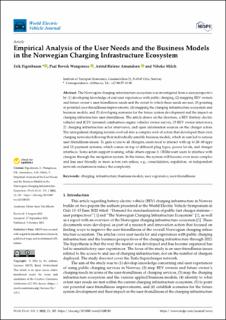| dc.contributor.author | Figenbaum, Erik | |
| dc.contributor.author | Wangsness, Paal Brevik | |
| dc.contributor.author | Amundsen, Astrid Helene | |
| dc.contributor.author | Milch, Vibeke | |
| dc.coverage.spatial | Norway, Oslo | en_US |
| dc.date.accessioned | 2023-06-16T10:12:01Z | |
| dc.date.available | 2023-06-16T10:12:01Z | |
| dc.date.created | 2022-10-03T15:34:47Z | |
| dc.date.issued | 2022-10-03 | |
| dc.identifier.citation | World Electric Vehicle Journal. 2022, 13 (185), . | en_US |
| dc.identifier.issn | 2032-6653 | |
| dc.identifier.uri | https://hdl.handle.net/11250/3071760 | |
| dc.description | Figenbaum, E.; Wangsness, P.B.; Amundsen, A.H.; Milch, V. Empirical Analysis of the User Needs and the Business Models in the Norwegian Charging Infrastructure Ecosystem. World Electr. Veh. J. 2022, 13, 185. https://doi.org/10.3390/wevj13100185 | en_US |
| dc.description.abstract | The Norwegian charging infrastructure ecosystem was investigated from a user perspective by (1) developing knowledge of end-user experiences with public charging, (2) mapping BEV owners and future owner’s user-friendliness needs and the extent to which these needs are met, (3) pointing at potential user-friendliness improvements, (4) mapping the charging infrastructure ecosystem and business models, and (5) developing scenarios for the future system development and the impact on charging infrastructure user-friendliness. The article draws on the literature, a BEV (battery electric vehicle) and ICEV (internal combustion engine vehicle) owner survey, 15 BEV owner interviews, 21 charging infrastructure actor interviews, and open information sources on the charger actors. The unregulated charging system evolved into a complex web of actors that developed their own charging networks following their individually sensible business models, which in sum led to serious user-friendliness issues. To gain access to all chargers, users need to interact with up to 20–30 apps and 13 payment systems, which comes on top of different plug types, power levels, and charger interfaces. Some actors support roaming, while others oppose it. OEMs want users to interface with chargers through the navigation system. In the future, the system will become even more complex and less user friendly as more actors join unless, e.g., consolidation, regulation, or independent network orchestrators reduce the complexity. | en_US |
| dc.language.iso | eng | en_US |
| dc.publisher | MDPI | en_US |
| dc.rights | Navngivelse 4.0 Internasjonal | * |
| dc.rights.uri | http://creativecommons.org/licenses/by/4.0/deed.no | * |
| dc.subject | charging | en_US |
| dc.subject | infrastructure | en_US |
| dc.subject | business models | en_US |
| dc.subject | user experience | en_US |
| dc.subject | user-friendliness | en_US |
| dc.title | Empirical Analysis of the User Needs and the Business Models in the Norwegian Charging Infrastructure Ecosystem | en_US |
| dc.title.alternative | Empirical Analysis of the User Needs and the Business Models in the Norwegian Charging Infrastructure Ecosystem | en_US |
| dc.type | Journal article | en_US |
| dc.type | Peer reviewed | en_US |
| dc.rights.holder | © 2022 by the authors. Licensee MDPI, Basel, Switzerland. This article is an open access article distributed under the terms and conditions of the Creative Commons Attribution (CC BY) license (https:// creativecommons.org/licenses/by/ 4.0/). | en_US |
| dc.description.version | publishedVersion | en_US |
| cristin.ispublished | true | |
| cristin.fulltext | original | |
| cristin.qualitycode | 1 | |
| dc.identifier.doi | 10.3390/wevj13100185 | |
| dc.identifier.cristin | 2058010 | |
| dc.source.journal | World Electric Vehicle Journal | en_US |
| dc.source.volume | 13 | en_US |
| dc.source.issue | 185 | en_US |
| dc.source.pagenumber | 1-24 | en_US |
| dc.relation.project | Norges forskningsråd: 321090 | en_US |
| dc.relation.project | Norges forskningsråd: 257653 | en_US |

